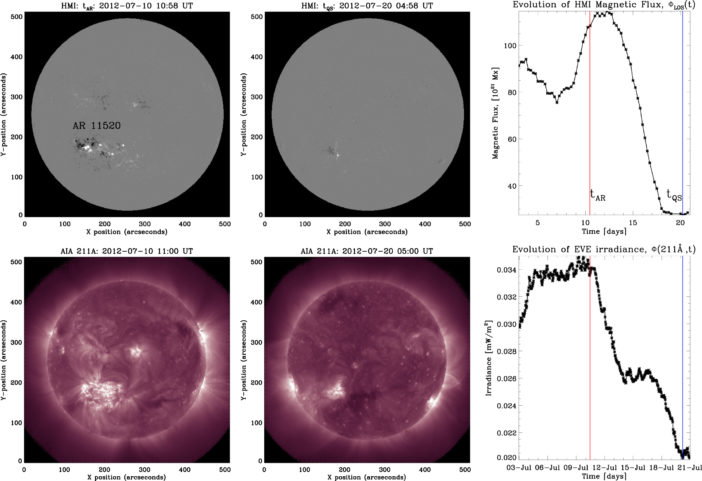How can we tell how much energy is leaking out of active regions on the Sun like the one shown in this Solar Dynamics Observatory (SDO) image above? Active regions are areas with especially strong magnetic fields, and they’re often associated with solar activity. But even when the Sun is generally quiet, these regions radiate energy away — and it’s important to understand how much.
To answer this question, scientists Maria Kazachenko (University of Colorado Boulder; National Solar Observatory) and Hugh Hudson (UC Berkeley; University of Glasgow, UK) used the Extreme Ultraviolet Variability Experiment on board SDO to measure unresolved spectra of the Sun as though it were a distant star. Kazachenko and Hudson compared data from periods when the Sun had no active regions to data from when only one active region was present, allowing them to identify the radiation specifically associated with the active region.
To learn more about the authors’ work, check out the original article below. And if you want to read more about “Sun-as-a-star” studies — studies like this one that treat the Sun as an unresolved source — you can check out this other recent ApJ study, which was announced in a press release today.

This full image from the article shows the magnetic fields (top two images) and SDO AIA 211 Å maps (bottom two images) for the Sun when one active region is present (left) and no active regions are present (right). The right column shows the disk-integrated magnetic flux (top) and a line-integrated spectrum (bottom) as the active region crosses the disk. [Kazachenko & Hudson 2020]
Citation
“Active Region Irradiance during Quiescent Periods: New Insights from Sun-as-a-star Spectra,” Maria D. Kazachenko and Hugh S. Hudson 2020 ApJ 901 64. doi:10.3847/1538-4357/abada6

1 Comment
Pingback: From AAS NOVA: “Featured Image: Exploring Active Regions on the Sun” | sciencesprings